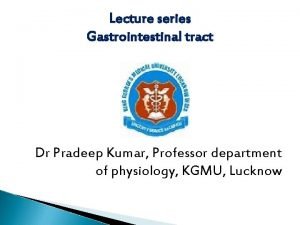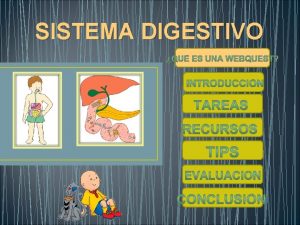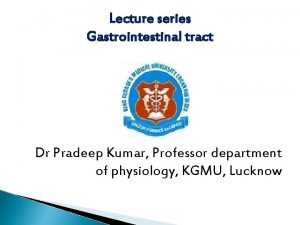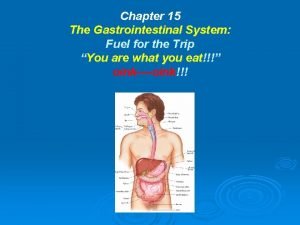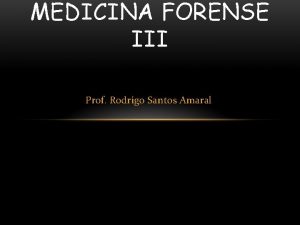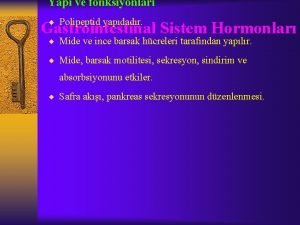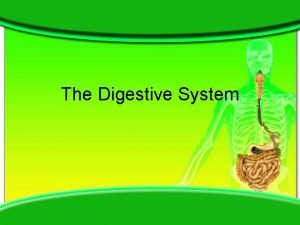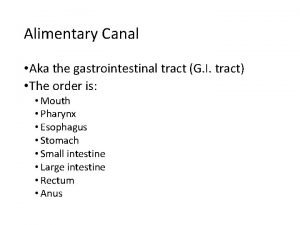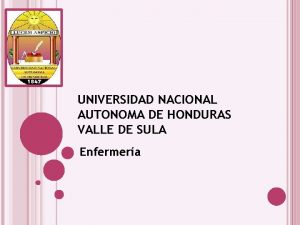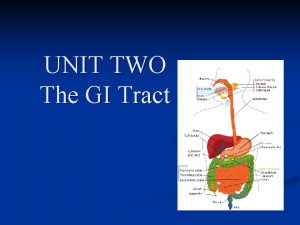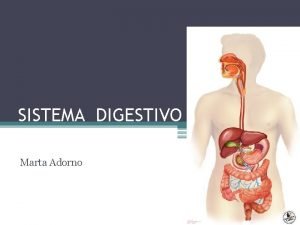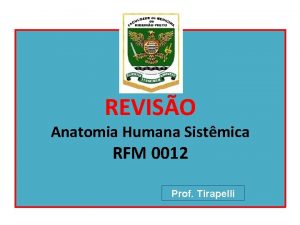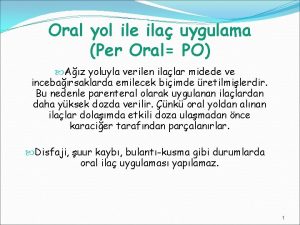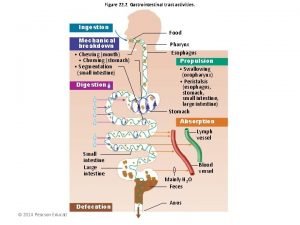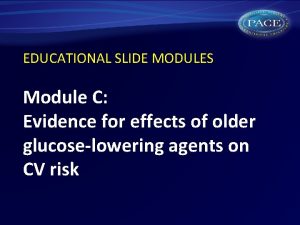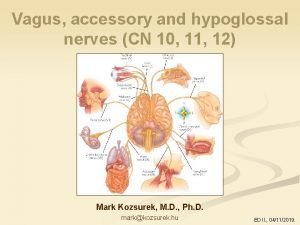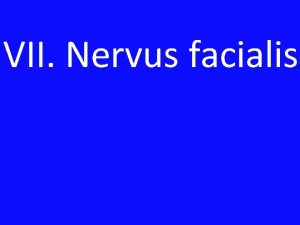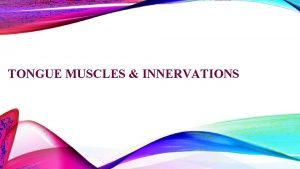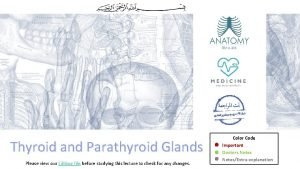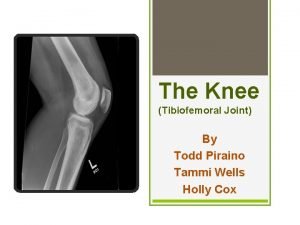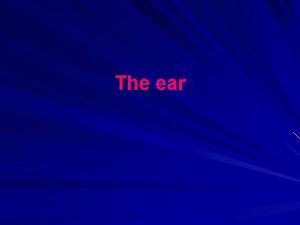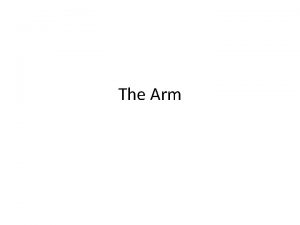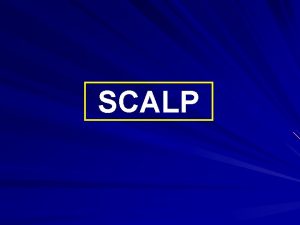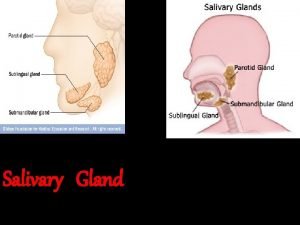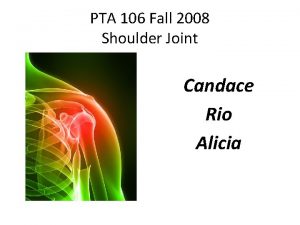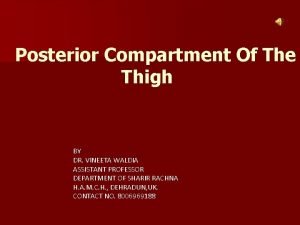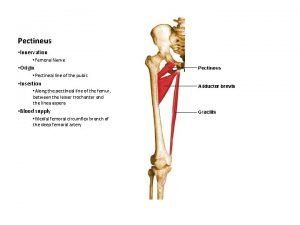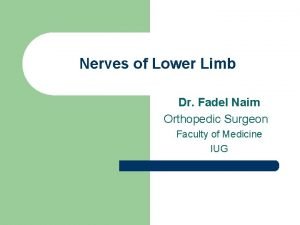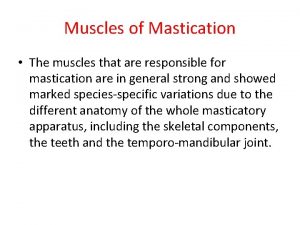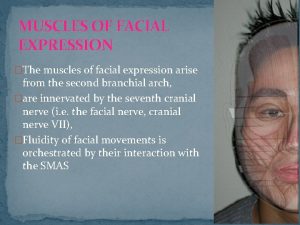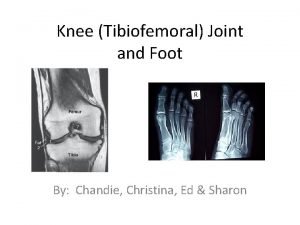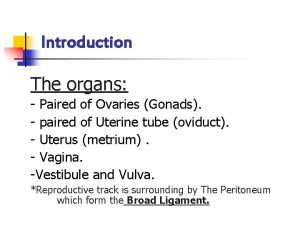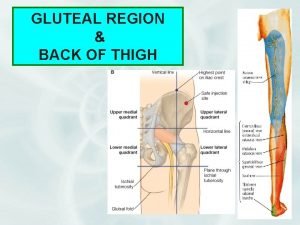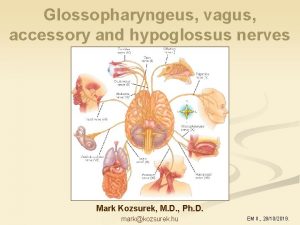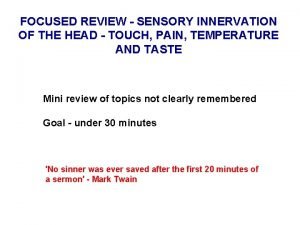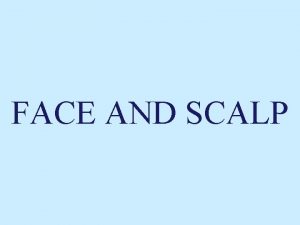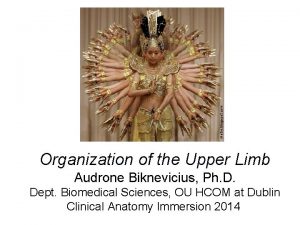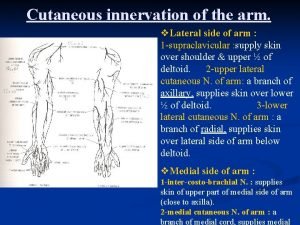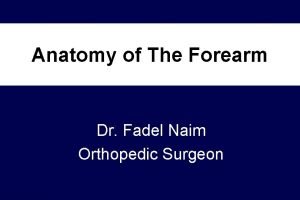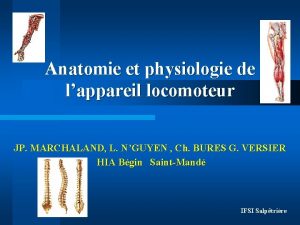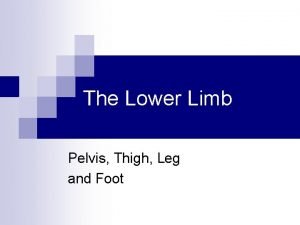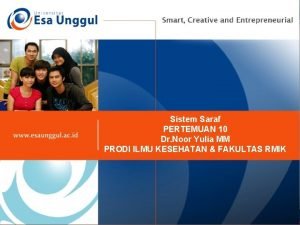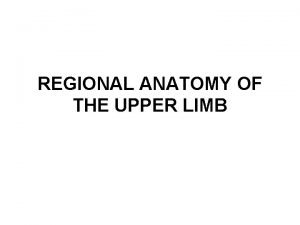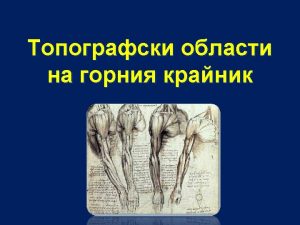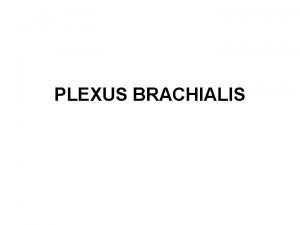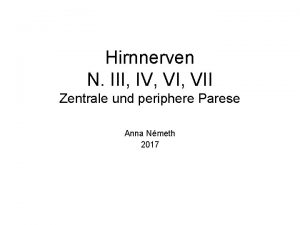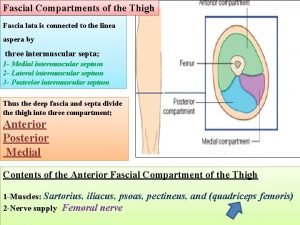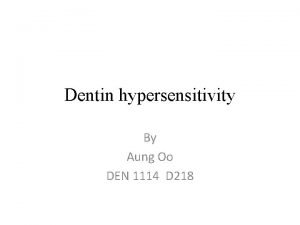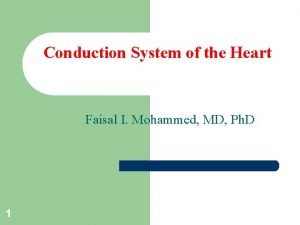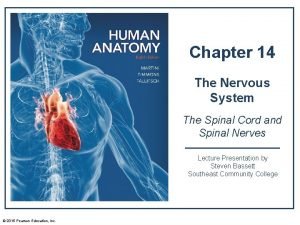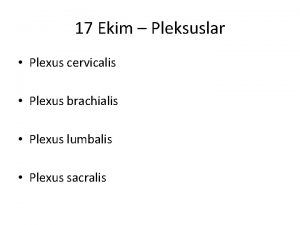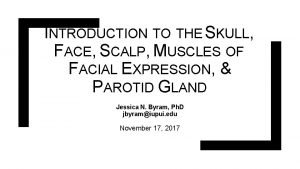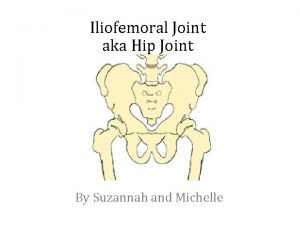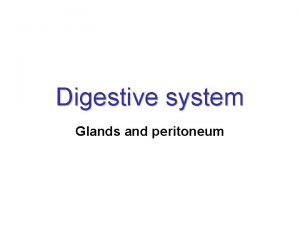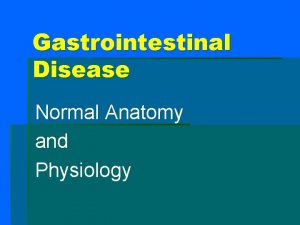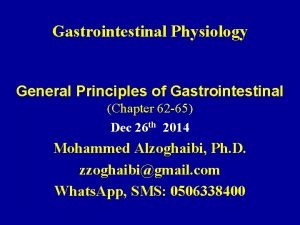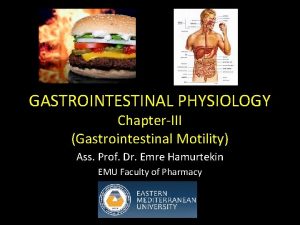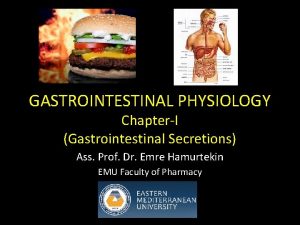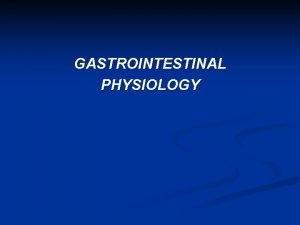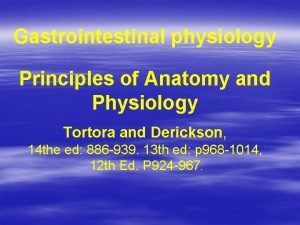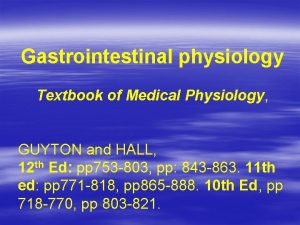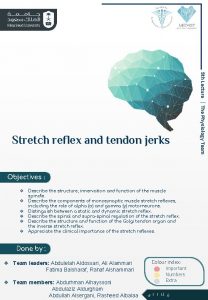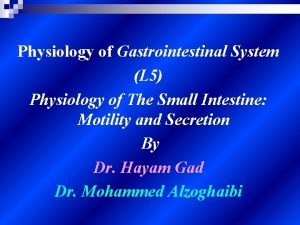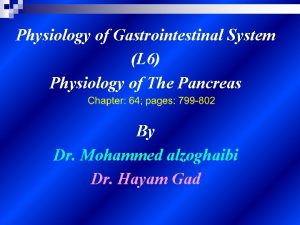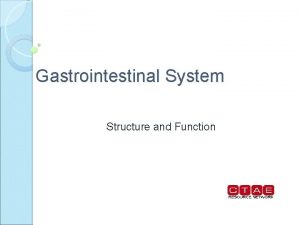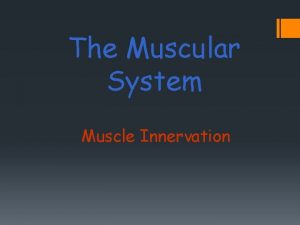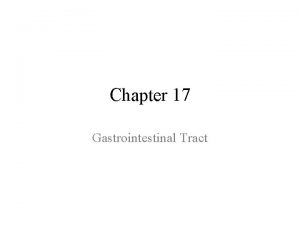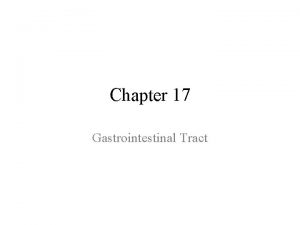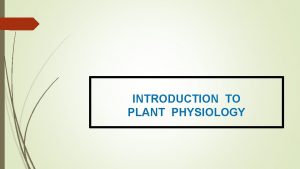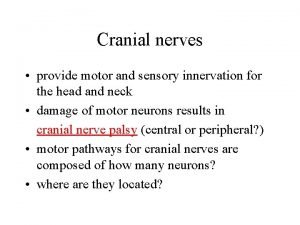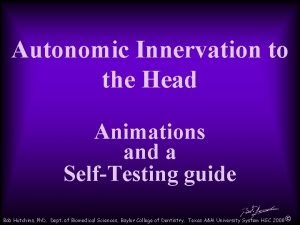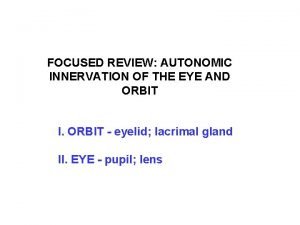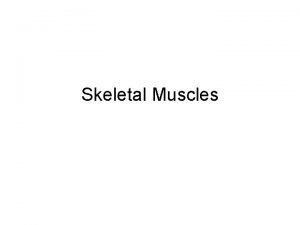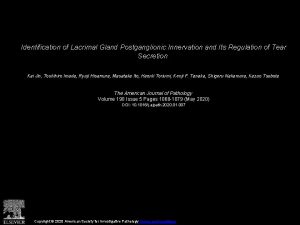Gastrointestinal Physiology Structure and Innervation of the Gastrointestinal






































































- Slides: 70

Gastrointestinal Physiology

Structure and Innervation of the Gastrointestinal Tract Structure of the gastrointestinal (GI) tract, Layers of the Gastrointestinal Tract 1. Mucosa: including A lining epithelium, including glandular tissue, an underlying layer of loose connective tissue called the lamina propria, which provides vascular support for the epithelium, and often contains mucosal glands. Products of digestion pass into these capillaries. Lymphoid follicles and plasma cells are also often found here. Finally, a thin double layer of smooth muscle is often present; the muscularis mucosa for local movement of the mucosa. 2. Sub-mucosa: A loose connective tissue layer, with larger blood vessels, lymphatic vessels, nerves, and can contain mucous secreting glands. 3. Muscularis propria (externa): There are usually two smooth muscle layer; the inner layer is circular (contraction causes decrease diameter), and the outer layer is longitudinal (contraction causes shorting). 4. Adventia layer (or serosa):

Gastrointestinal Smooth Muscle Functions as a Syncytium. The individual smooth muscle fibers in the gastrointestinal tract are 200 to 500 micrometers in length and 2 to 10 micrometers in diameter, and they are arranged in bundles of as many as 1000 parallel fibers. In the longitudinal muscle layer, the bundles extend longitu dinally down the intestinal tract; in the circular muscle layer, they extend around the gut. Within each bundle, the muscle fibers are electrically connected with one another through large numbers of gap junctions that allow low-resistance movement of ions from one muscle cell to the next. Therefore, a. electri cal signals that initiate muscle contractions can travel readily from one fiber to the next within each bundle but more rapidly along the length of the bundle than sideways. b. The distance that electri cal signals travels depends on the excitability of the muscle; sometimes it stops after only a few millimeters, and at other times it travels many centime ters or even the entire length and breadth of the intes tinal tract. Each bundle of smooth muscle fibers is partly sepa rated from the next by loose connective tissue, but the muscle bundles fuse with one another at many points, so in reality each muscle layer represents a branching latticework ﺣﺼﻴﺮﺓ of smooth muscle bundles. Therefore, each muscle layer functions as a syncytium; that is, when an action potential is elicited anywhere within the muscle mass, it generally travels in all directions in the muscle. Also, because a few connections exist between the

Innervation of the GI tract • The autonomic nervous system (ANS) of the GI tract comprises both extrinsic and intrinsic nervous systems. 1. Extrinsic innervation (parasympathetic and sympathetic nervous systems) • Efferent fibers carry information from the brain stem and spinal cord to the GI tract. • Afferent fibers carry sensory information from chemo-receptors (activated by H+, proteins, and lipids in chyme), mechano-receptors (activated by distension of the digestive walls by food (bolus or chyme) and osmo-receptors (activated by amino acids and glucose) in the GI tract to the brain stem and spinal cord a. Parasympathetic nervous system • is usually excitatory on the functions of the GI tract. • is carried via the vagus and pelvic nerves. • Pre-ganglionic parasympathetic fibers synapse in the enteric plexuses. • Post-ganglionic parasympathetic fibers: Cell bodies in the ganglia of the enteric plexuses then send information ﺍﻟﺘﺎﻟﻴﺔ ﺍﻟﺘﺮﻛﻴﺒﺎﺕ ﻣﻊ ﻣﺒﺎﺷﺮ ﺍﺗﺼﺎﻝ ﻻﻳﻮﺟﺪ to the smooth muscle, secretory cells, and endocrine cells of the GI tract. , all effects of vagal and pelvic efferent neurons are mediated via synapses on enteric neurons (1) The vagus nerve innervates the esophagus, stomach, pancreas, and upper large intestine. • Reflexes in which both afferent and efferent pathways are contained in the

b. Sympathetic nervous system • is usually inhibitory on the functions of the GI tract • Fibers originate in the spinal cord between T-8 and L-2. • Pre-ganglionic sympathetic cholinergic fibers synapse in the prevertebral ganglia. • Postganglionic sympathetic adrenergic fibers leave the prevertebral ganglia and synapse in a. the enteric plexuses. Cell bodies in the ganglia of the enteric plexuses then send information to the smooth muscle, secretory cells, and endocrine cells of the GI tract; b. End on post-ganglionic cholinergic neurons, where the nor-epinephrine they secret inhibits acetylcholine secretion

• Extrinsic nerves functions: The autonomic nerves influence digestive tract motility and secre tion either by modifying ongoing activity in the intrinsic plex uses, altering the level of gastrointestinal hormone secretion acting directly on the smooth muscle and glands. One of the major purposes of specific activation of extrinsic innervations is to coordinate activity between different regions of the digestive system. The parasympathetic nerve fibers supplying the digestive tract, which arrive primarily by way of the vagus nerve, tend to increase smooth muscle motility promote secretion of digestive enzymes and hormones. The sympathetic nervous system activation has an opposite effect The autonomic nerves, especially the vagus nerve, can be discretely

In GIT the neurotransmitter are either major neurotransmitters (1) acetyl choline, (2) norepinephrine, (3) adenosine triphosphate, (4) serotonin, (5) dopamine, (6) cholecystokinin, (7) sub stance P, (8) vasoactive intestinal polypeptide, (9) somatostatin, (10) leu-enkephalin, (11) met-enkephalin (12) bombesin and (13) nitric oxide neuropeptides. Neuropeptides are short chains of amino acids; Neuropeptides may act as hormones or neurotransmitter. The primary criteria of neurotransmitter are: 1. the substance must be present within the presynaptic neuron 2. The substance must be released in response to presynaptic depolarization 3. Specific receptors for the substance must be present on the postsynaptic cell. Acetylcholine most often excites gastrointestinal activity.

2. Intrinsic innervation (enteric nervous system) Enteric nervous system comprises submucosal plexus and myenteric plexus Enteric nervous system lies entirely in the wall of the gut Enteric nervous system beginning in the esophagus and extending all the way to the anus. Enteric nervous system number of neurons is about 100 million, nearly equal to the number of neurons in the entire spinal cord. A. Enteric nervous system integrates ﻳﻜﻤﻞ and coordinates ﻳﻨﺴﻖ the ﺗﻨﺴﻖ motility, secretory, and endocrine functions of the GI tract. B. Enteric nervous system coordinates and relays ﻳﺤﻮﻝ information from the parasympathetic and sympathetic nervous systems to the GI tract. ﺍﻻﻭﺍﻣﺮ ﺗﻨﻘﻞ C. The enteric nervous system (ENS) generates and modulates many digestive functions especially motility and secretion without

The enteric nervous system consists of nerve cell bodies that are connected by their processes to form two major ganglionated plexi in the digestive tract: a. Myenteric plexus (Auerbach's plexus) The myenteric plexus consists mostly of a linear chain of many interconnecting neurons The myenteric plexus extends the entire length of the gastrointestinal tract. The myenteric plexus is located between the circular and longitudinal smooth muscle layers The myenteric plexus primarily controls the motility of the GI smooth muscle. Because the myenteric plexus extends all the way along the intestinal wall and lies between the longitudinal and circular layers of intestinal smooth muscle, it is concerned mainly with controlling muscle activity along the length of the gut. The myenteric plexus should not be considered entirely excitatory because some of its neurons are inhibitory; their fiber endings secrete an inhibitory transmitter, possibly vasoactive intestinal polypeptide(VIP) or some other inhibitory peptide. The resulting inhibitory signals are especially useful for inhibiting some of the intestinal sphincter muscles that impede movement of food along successive segments of the gastrointestinal tract, such as the pyloric sphincter and ileocecal valve, When the myenteric plexus is stimulated, its principal effects are (1) ↑ tonic contraction, or “tone, ” of the gut wall; (2) ↑intensity of the rhythmical contractions;

b. Sub-mucosal plexus (Meissner's plexus) • is located between the inner layer of the circular muscle layer and the submucosa • Primarily controls secretion and blood flow. The submucosal plexus, in contrast to the myenteric plexus, is mainly concerned with controlling function within the inner wall of each minute segment of the intestine. For instance, many sensory signals originate from the gastrointestinal epithelium and are then integrated in the sub-mucosal plexus to help control local intestinal secretion, local absorption, and local contraction of the sub-mucosal muscle that causes various degrees of in folding of the gastrointestinal mucosa. • receives sensory information from chemoreceptors and mechanoreceptors in the GI tract. The extrinsic sympathetic and parasympathetic fibers that connect to both the myenteric and submucosal plexuses. Although the enteric nervous system can function independently of these extrinsic nerves, stimulation by the parasympathetic and

Some are sensory neurons; other local neurons innervate the smooth muscle cells and exocrine and endocrine cells of the digestive tract to directly af fect digestive tract motility, secretion of digestive juices, and secretion of gastrointestinal hormones. These intrinsic nerve networks primarily coordinate local activity within the digestive tract The enteric nervous system contains A. sensory or afferent neurons (sometimes called intrinsic primary afferent neurons [IP ANs]) that sense the environment so can be stimulated by chemoreceptors: any chemical changes (eg, intestinal p. H, osmor lality, irritation (toxins) mechanoreceptors wall stretch B. inter-neurons (the connectors) As with the cen tral nervous system, these input and output neurons of the enteric nervous system are linked by inter-neurons. Some of

3. Interstitial cells of Cajal (Gastrointestinal action potential and Mechanical contraction): The interstitial cells of cajal are specialized pacemaker cells The interstitial cells of cajal are located between the smooth muscle in the wall of the stomach, small intestine, and large intestine. The interstitial cells of cajal are connected to the smooth muscle and the myentric plexus via gap junctions. The functions of interstitial cells of Cajal are (a) Generation of electrical slow wave activity, Interstitial cells of Cajal are the pacemaker cells, which have the capacity to generate the basic electric rhythm or slow wave of smooth muscle. (b) coordination of pacemaker activity and (c) active propagation of slow waves, (d) transduction of motor neural inputs from the enteric nervous system to the smooth cells enteric nervous system ►interstitial cells of Cajal transmit ►to the smooth cells (e) mechano-sensation to stretch of GI muscles (f) setting the membrane potential gradient of gut smooth muscles.

These cells characterizes by: 1. These cells are stellate mesenchymal (mesenchme: the tissue from which all connective eventually arise) pacemaker cells with smooth muscle-like feature that send long multiply branched processes into the intestinal smooth muscle. 2. In stomach and the small intestine, these cells are located in the outer circular muscle layer near the myenteric plexus; in the colon, they are at the sub-mucosal layer. 3. In the stomach and small intestine, there is a descending gradient in pacemaker frequency, and as in the heart, the pacemaker with higher frequency usually dominate. 4. ICC have been grouped according to either their A. localization within the muscle layers intramuscular ((ICC-IM) are involved in the stimulation of smooth muscle cells, neurotransmitters act through them submuscular myenteric ((ICC-MY) serve as a pacemaker which creates the bioelectrical slow wave that leads to contraction of smooth muscle subserosal: their basic morphology (stellate and bipolar B. their primary function pacemakers cells that mediate neuromuscular neurotransmission mechano-reception

Slow wave: The cell membranes of the pacemaker cells (interstitial cells of Cajal) undergo a rhythmic depolarization and repolarization from -65 m. V to -45 m. V. This rhythm of depolarization-repolarization of the cell membrane creates a slow wave (general name for spontaneous electrical rhythm) known as a BER (Basal or Basic electrical rhythm (BER) or electrical control activity (ECA): specific name of slow wave in GIT), and it is transmitted to the smooth muscle cells. Slow wave are undulating ﻣﺘﻤﻮﺝ and regular change in resting membrane potential Slow wave are produced by interstitial cell of cajal Slow wave are not action potentials. Slow waves are rhythmic, wave-like fluctuations in membrane potential (between -65 and -45 m. V) that cyclically bring the membrane closer to or farther from threshold potential. Slow waves is not seen in the esophagus and the proximal portion of the stomach Slow wave when reach a threshold action potential appears

Slow wave do cause smooth muscle contraction only when spike potential occurs; except perhaps in the stomach. GI smooth muscle have unstable resting membrane potential of ( -65 m. V to -45 m. V). If the slow wave potential rise above (-40 m. V), spike potential (true action potential) appears superimposed on the slow wave. The rate of the BER is about 4/min in the stomach. It is about 12/min in the duodenum and falls to about 8/min in the distal ileum. In the colon, the BER rate rises from about 2/min at the cecum to about 6/min at the sigmoid. The function of the BER is to coordinate peristaltic and other motor activity; contractions occur only during the depolarizing part of the waves. After vagotomy or transection of the stomach wall, for example, peristalsis in the stomach becomes irregular and chaotic.

Sheets of smooth muscle cells are connected by gap junctions through whom chargecarrying ions can flow. In this way, electrical activity initi ated in a digestive-tract pacesetter cell spreads to the adjacent contractile smooth-muscle cells. The whole muscle sheet behaves like a functional syncytium, becoming excited and contracting as a unit when threshold is reached. If threshold is not achieved, the oscillating slow-wave electrical activity across the muscle ﻳﺰﻳﻞ continues to sweep sheet without being accompanied by contractile activity. Threshold is reached depends on the effect of various mechanical, neural, and hormonal factors that influ ence the starting point around which the slow-wave rhythm

Important difference between the action potentials of the gastrointestinal smooth muscle and those of nerve fibers 1. The spike potentials duration: The spike potentials spike lasting as long as 10 to 20 milliseconds. The spike potentials last 10 to 40 times as long in gastrointestinal muscle as the action potentials in large nerve fibers the higher the frequency of spike potential ►the higher smooth muscle tension (force of contraction) 2. Ionic bases of slow wave Slow wave without spike potential: Depolarization: opening Fast Na channels, Repolarization: opening of K channels Slow wave with spike potential: Depolarization: opening Ca-Na channels, Repolarization: opening of K channels

Among the principle factors that can increase the basal electrical rhythm of GI smooth muscle making them to be more excitable and less negative (depolarization) including : stretch, acetylcholine, parasympathetic stimulation, some GI hormones These factors Increase the frequency of spikes (and contraction) as well as the force of contraction The number of spikes in slow wave will determine the degree of contraction. Among the principle factors that can decrease the basal electrical rhythm of GI smooth muscle making them to be less excitable including and more negative (hyperpolarization): sympathetic stimulation, epinephrine and norepinephrine These factors decrease the frequency of spikes (and contraction) as well as the force of contraction Innervation of smooth muscle cells. Two mechanisms for neuronal innervation of gastrointestinal smooth muscle exist. a. Most innervation occurs through interstitial cells of Cajal. b. Neurons can also directly innervate intestinal smooth muscle cells.

Entry of Calcium Ions Causes Smooth Muscle Contraction The slow waves do not cause calcium ions to enter the smooth muscle fiber (they only cause entry of sodium ions). Therefore, the slow waves by themselves usually do not cause muscle contraction. Instead, it is during the spike potentials, generated at the peaks of the slow waves, that significant quantities of calcium ions enter the fibers and cause most of the contraction. Spike potential allows L-type calcium channel and Na-Ca channels to open which causes smooth muscle contraction Gastrointestinal Reflexes The anatomical arrangement of the enteric nervous system and its connections with the sympathetic and parasympathetic systems support three types of gastrointestinal reflexes that are essential to gastrointestinal control: 1. Local Reflexes: that are integrated entirely within the gut wall enteric nervous system. These reflexes include those that control much gastrointestinal secretion, peristalsis, mixing contractions,

2. Regional Reflexes: from the gut ► the pre-vertebral sympathetic ganglia ►back to the gastrointestinal tract. These reflexes transmit signals long distances to other areas of the gastrointestinal tract, such as the gastro-colic reflex signals from the stomach to cause evacuation of the colon (), the entero-gastric reflexes signals from the colon and small intestine to inhibit stomach motility and stomach secretion the colono-ileal reflexes from the colon to inhibit emptying of ileal contents into the colon 3. Systemic Reflexes: from the gut ► the spinal cord or brain stem ► then back to the gastrointestinal tract. These reflexes include especially (a) Vagovagal reflex from the stomach and duodenum to the brain stem and back to the stomach—by way of the vagus nerves (vagus do have afferent sensory and efferent motor) to control gastric motor and secretory activity; (b) pain reflexes that cause general inhibition of the entire gastrointestinal

Regulatory Substances in the Gastrointestinal Tract GI hormone can be classified depending on structure to two families: The gastrin family: the primary members of which are gastrin chole-cysto-kinin(CCK). The secretin family: secretin, glicentin, VIP (vaso-active intestinal peptide), and gastric inhibitory peptide (GIP). GI hormone can be classified depending on function to A. GI endocrine (hormones) GI hormones are released from endocrine cells in the GI mucosa ►portal circulation, ►general circulation ►physiologic actions on target cells. Four substances meet the requirements to be considered "official" GI hormones; others are considered "candidate" ﻣﺮﺷﺢ hormones. The four official GI hormones are gastrin,

1. Gastrin is produced by cells called G cells in the lateral walls of gastric glands in the antral portion of the gastric mucosa. Gastrin found in other organs in addition to stomach, including pituitary gland, hypothalamus, medulla oblongata, vagus and sciatic nerve. Gastrin contains 17 amino acids ("little gastrin"). Little gastrin is the form secreted in response to a meal. Gastrin other form is "Big gastrin" contains 34 amino acids, although it is not a dimer of little gastrin. Gastrin all biologic activity resides in the four C-terminal amino acids. Gastrin different forms are tailored ﻣﺨﺼﺺ for different action. G 17 have half-life of 2 to 3 minutes in the circulation, whereas G 34 has a half-life of 15 min a. Actions of gastrin 1. Stimulation of gastric acid and pepsin secretion. 2. Stimulation of growth of mucosa of the stomach, and small and large intestines (trophic action). Stimulates growth of gastric mucosa by stimulating the synthesis of RNA and new protein. Patients with gastrin-secreting tumors have hypertrophy ( size of cells) and hyperplasia ( number of cells) of the gastric mucosa.

b. Stimuli for secretion of gastrin 1. Luminal: Small peptides and amino acids, Distention of the stomach. 2. Neural: Vagal stimulation, mediated by gastrin-releasing peptide (GRP) Atropine does not block vagally mediated gastrin secretion because the mediator of the vagal effect is GRP, not acetylcholine (Ach). 3. Blood borne: Calcium (hypercalcemia), Epinephrine c. Inhibition of gastrin secretion 1. Luminal: acid in the antrum inhibit secretion partly by direct action on G cells and partly by release of somatostatin. The effect of acid is biased on negative feed-back loop regulating gastrin secretion. This negative feedback control ensures that gastrin secretion is inhibited if the stomach contents are sufficiently acidified. This is why in pernicious anemia in which the acid-secreting cells of the stomach are damaged, gastrin secretion is chronically elevated. 2. Blood borne: Secretin, somatostatin, GIP (Gastric inhibitory polypeptide also known as the glucose-dependent insulin-tropic peptide), VIP (vasoactive intestinal peptide), glucagon d. Zollinger-Ellison syndrome (gastrinoma)

2. CCK (chole-cysto Kinin) or Chole-cysto-kinin Pancero-zymin (CCK-PZ) CCK half-life of circulating is about 5 minute. CCK is secreted from I cells in duodenum and jejunum. CCK In the brain, especially the cerebral cortex, may be involved in regulation of food intake CCK appears to be related to the production of anxiety and analgesia. CCK contains 33 amino acids. CCK is homologous to gastrin. The five C-terminal amino acids are the same in CCK and gastrin. • The biologic activity of CCK resides in the C-terminal heptapeptide (7). Thus, the heptapeptide contains the sequence that is homologous to gastrin and has gastrin activity as well as CCK activity. a. Actions of CCK (1) Stimulates contraction of the gallbladder and simultaneously causes relaxation of the sphincter of Oddi for secretion of bile. (2) Stimulates pancreatic enzyme secretion. (3) Potentiates secretin-induced stimulation of pancreatic HCO 3 - secretion.

(4) Stimulates growth (trophic effect) of the exocrine pancreas. (5) Inhibits gastric emptying. Thus, meals containing fat stimulate the secretion of CCK, which slows gastric emptying to allow more time for intestinal digestion and absorption. (6) CCK and secretin augments the contraction of the pyloric sphincter Number 1+5+6 to give adequate time for digestion of the fats in the upper intes tinal tract. (7)Increase the secretion of entero-kinase. (8) Enhance the motility of the small intestine and colon. (9)Gastrin and CCK stimulate glucagon secretion after protein meal. (10) Inhibits appetite to prevent overeat ing during meals by stimulating sensory afferent nerve fibers in the duodenum; these fibers, in turn, send signals by way of the vagus nerve to inhibit feeding centers in the brain b. Stimuli for the release of CCK (1) Small peptides and amino acids (2) Fatty acids containing more than 10 carbon atoms and monoglycerides • Triglycerides do not stimulate the release of CCK because they cannot cross intestinal cell membranes.

3. Secretin The secretin contains 27 amino acids, The secretin synthesized by S cells, which are found in the mucosa of the duodenum and the jejunum of the gastrointestinal tract. The secretin half-life is about 5 minute. All of the amino acids are required for biologic activity. The secretin is homologous to glucagon; 12 of the 27 amino acids in secretin are the same as those in glucagon. a. Actions of secretin • are coordinated to reduce the amount of H+ in the lumen of the small intestine. (1) Secretin increase secretion of bicarbonate by the duct cells of the pancreas and biliary tract. A. Secretin thus causes the secretion of watery, alkaline pancreatic juice. Pancreatic HCO 3 - neutralizes H+ in the intestinal lumen. B. Secretin Stimulates HCO 3 - and H 2 O secretion by the liver, and increases bile production. (3) Secretin Inhibits H+ secretion by gastric parietal cells. (4) Secretin increases growth of the exocrine pancreas. (5) Secretin augments the action of CCK in producing pancreatic secretion of digestive enzyme. (6)Secretin has a mild effect on motility of the gastrointestinal tract b. Stimuli for the release of secretin • Secretin is released by the S cells of the duodenum in response to:

4. GIP (Glucose-dependent insulin-tropic peptide or Gastroinhibitory peptide) GIP contains 42 amino acids. GIP is produced by K cells in the mucosa of the duodenum and jejunum. GIP is homologous to secretin and glucagon. a. Actions of GIP (1) Stimulates insulin release. In the presence of an oral glucose load, GIP causes the release of insulin from the pancreas. Thus, oral glucose is more effective than intravenous glucose in causing insulin release and, therefore, glucose utilization. (2) Large dose (not small dose) of this hormone A. inhibits gastric secretion (H+ secretion by gastric parietal cells) B. inhibits gastric motility this why this hormone named gastric inhibitory peptide b. Stimuli for the release of GIP

5. Motilin is secreted by the stomach and upper duode num during fasting, Motilin only known function of this hormone is to increase gastrointestinal motility. Motilin secretion is inhibited after ingestion of food by mechanisms that are not fully understood. Motilin is released cyclically and stimulates waves of gastrointes tinal motility called interdigestive myoelectric complexes (or migrating myoelectric complexes: MMC) that move through the stomach and small intestine every 90 minutes in a person who has fasted and MMC contraction stop when you eat The migrating myoelectric complex functions to move undigested food into the colon and keep the upper parts of the GIT (small intestine and stomach) clear The mid stomach to the terminal ileum parts of the GIT can have an active migrating myoelectric complex Inter-digestive myoelectric complexes (or MMC) is often divided into four consecutive phases (1) basal (Phase I) is a quiescent ﻫﺎﻣﺪ period with virtually no contractions lasts from 40– 60 min (2) pre-burst (Phase II) consists of intermittent, irregular low-amplitude contractions lasts for 40– 60 min

(3) burst (Phase III) consists of intense short burst of regular high- amplitude contractions for short periods (4– 6 min). Due to this contraction all the undigested material is swept out of the stomach down to the small intestine. This is also known as the housekeeper wave. Phase III contractions periodically occur every 90 -120 minutes in humans. Plasma motilin level is highly associated with the appearance of gastric phase III in humans Plasma motilin levels vary in a cyclic fashion and its peaks regularly occur every 90 -100 minutes during the period of gastric phase III in humans. Motilin administration causes gastric phase III contractions in humans. (4) Phase IV represents a short transition period back to the quiescence ﺍﻟﻬﺪﻭﺀ of phase I and lasts for 0– 5 min, with very little or no contractions.

B. GI Paracrines • are released from endocrine cells in the GI mucosa. • diffuse over short distances to act on target cells located in the GI tract. • The GI paracrines are somatostatin and histamine. 1. Somatostatin is secreted by cells throughout the GI tract Somatostatin is secreted in response to H+ in the lumen. Somatostatin secretion is inhibited by vagal stimulation. Somatostatin inhibits pancreatic exocrine secretion; gastric acid secretion and motility; gallbladder contraction the absorption of glucose, amino acid, and triglycerides. the release of all GI hormones 2. Histamine • is secreted by mast cells of the gastric mucosa. • increases gastric H+ secretion directly and by potentiating the effects of gastrin and vagal stimulation

C. GI Neurocrines • Neurocrines are synthesized in neurons of the GI tract, moved by axonal transport down the axon, and released by action potentials in the nerves; then diffuse across the synaptic cleft to a target cell. • The GI neurocrines are vasoactive intestinal peptide (VIP), GRP (bombesin), and enkephalins. 1. Vasoactive intestinal peptide (VIP) VIP contains 28 amino acids and is homologous to secretin. VIP is released from neurons in the mucosa, smooth muscle of the GI tract and blood VIP has a half-life of about 2 minutes Functions of VIP Produces relaxation of GI smooth muscle, including the a. relaxation lower esophageal sphincter b. dilation of peripheral blood vessels Stimulates pancreatic HCO 3 - secretion and inhibits gastric H+ secretion. ‘In these actions, it resembles secretin. VIP markedly stimulate intestinal secretion of electrolytes and hence of

2. GRP (Gastrin Releasing peptide or bombesin) • is released from vagus nerves that innervate the G cells. • stimulates gastrin release from G cells. 3. Enkephalins (met-enkephalin and leu-enkephalin) • stimulate contraction of GI smooth muscle, particularly the lower esophageal, pyloric, and ileocecal sphincters. • inhibit intestinal secretion of fluid and electrolytes. This action forms the basis for the usefulness of opiates in the treatment of diarrhea. Gastrointestinal Motility • Contractile tissue of the GI tract is almost exclusively unitary smooth muscle, with the exception of the pharynx, upper one-third of the esophagus, and external anal sphincter, all of which are striated muscle.

Single-unit smooth muscle tissues: the autonomic nervous system innervates a single cell within a sheet or bundle and the action potential is propagated by gap junctions to neighboring cells such that the whole bundle or sheet contracts as a syncytium. • Depolarization of circular muscle leads to contraction of a ring of smooth muscle and a decrease in diameter of that segment of the GI tract. • Depolarization of longitudinal muscle leads to contraction in the longitudinal direction and a decrease in length of that segment of the GI tract. • Phasic contractions: Phasic contraction is twitch-like shortening followed by relaxation. Phasic contraction occur in the

Tonic contractions: Tonic contractions occur in the a. lower esophageal sphincter, b. orad stomach (fundus and superior part of the body), c. ileo-cecal sphincters d. internal anal sphincters. Tonic contractions is sustained contraction of a muscle without relaxation The tonic contraction is continuous often lasts several minutes or even hours. The tonic contraction is NOT associated with the basic electrical rhythm of the slow waves The tonic contraction often increases or decreases in intensity but continues. The tonic contraction is sometimes caused by 1. Continuous repetitive spike potentials—the greater the frequency, the greater the degree of contraction. 2. Hormones or other factors that bring about continuous partial depolarization of the smooth muscle membrane without causing action poten tials. 3. Continuous entry of calcium ions into the interior of the cell brought about in ways

Functional types of movements in GIT Two types of movements occur in the gastrointestinal tract: (1) Propulsive movement (Peristalsis) Propulsive movement which is the basic movement of the gastrointestinal tract is peristalsis. Propulsive movements (Peristalsis) is a reflex response that is initiated when the gut wall is stretched by the contents of the lumen, The stretch initiates a circular contraction behind the stimulus and an area of relaxation in front of it. The wave of contraction then moves in an oral-to-caudal direction, propelling the contents of the lumen forward at rates that vary from 2 to 25 cm/s. Propulsive movements occurs in all parts of the gastrointestinal tract from the esophagus to the rectum. Propulsive movements (Peristalsis) activity can be increased or decreased by the autonomic input to the gut Propulsive movements (Peristalsis) occurrence is independent of the extrinsic innervation. Propulsive movements (Peristalsis) progression of the contents Propulsive movements is not blocked by removal and re-suture ﺧﻴﺎﻃﺔ ﺍﻋﺎﺩﺓ of a segment of intestine in its Propulsive movements original position is blocked only if the segment is reversed before it is sewn ﺧﻴﻂ back into place.

Propulsive movements (Peristalsis) is an excellent example of the integrated activity of the enteric nervous system. Propulsive movements (Peristalsis) appears that local stretch releases serotonin, ▼ activates sensory neurons ▼ activate the myenteric plexus + A. Cholinergic neurons passing in a retrograde direction in this plexus activate neurons that release substance P and acetylcholine, causing smooth muscle contraction. B. cholinergic neurons passing in an anterograde direction activate neurons that secrete NO, vasoactive intestinal polypeptide (VIP), and adenosine triphosphate (ATP), producing the relaxation ahead of the stimulus. Effectual peristalsis requires an active myenteric plexus The usual stimulus for intestinal peristalsis is A. disten tion of the gut. . B. chemical or C. strong parasympathetic nervous signals to the gut will elicit strong peristalsis. It is greatly depressed or completely blocked in the entire gut when a person is treated with atropine to paralyze the cholinergic nerve endings of the myenteric plexus.

“Law of the Gut. ” Peristalsis, theoretically, can occur in either direc tion from a stimulated point, but it normally dies out rapidly in the orad (toward the mouth) direction while continuing for a considerable distance toward the anus. The peristaltic reflex plus the anal direction of movement of the peristal sis is called the “law of the gut. ” (2)Mixing movement: Mixing movements, which keep the intestinal contents thoroughly mixed at all times. Mixing movements differ in different parts of the alimen tary tract: A. In some areas, the peristaltic contractions cause most of the mixing. This is especially true when forward progression of the intestinal contents is blocked by a sphincter so that a peristaltic wave can then only chyrn ﻳﺨﺾ the intestinal contents, rather than propelling them forward.

B. At other times, local intermittent constrictive contractions occur every few centimeters in the gut wall. These constrictions usually last only 5 to 30 seconds; new constrictions then occur at other points in the gut, thus “chopping” and “shearing” the contents first here and then there. Unlike peristalsis, therefore, retrograde movement of the chyme occurs routinely in the setting of segmentation. This mixing pattern persists for as long as nutrients remain in the lumen to be absorbed. It presumably reflects programmed activity of the bowel dictated ﻣﻘﺮﺭ by the enteric nervous system, and can occur independent of central input, although the latter can modulate it.

Effect of GUT activity and metabolic factors on gastrointestinal blood flow Under normal conditions, the blood flow in each area of the gastrointestinal tract, as well as in each layer of the gut wall, is directly related to the level of local activity. after a meal, the motor activity, secretory activity, and absorptive activity all increase; likewise, the blood flow increases greatly but then decreases back to the resting level over another 2 to 4 hours. For instance, during active absorption of nutrients, blood flow in the villi and adjacent regions of the submucosa increases as much as eightfold. blood flow in the muscle layers of the intestinal wall increases with increased motor activity in the gut. Possible causes of the increased blood flow during gastrointestinal activity. Although the precise causes of the increased blood flow during increased gastrointes tinal activity are still unclear, some facts are known. First, several vasodilator substances are released from the mucosa of the intestinal tract during the digestive process. Most of these substances are peptide hormones, including cholecystokinin, VIP, gastrin, and

Second, some of the gastrointestinal glands also release into the gut wall two kinins, kallidin and bradykinin, at the same time that they secrete other substances into the lumen. These kinins are powerful vasodilators that are believed to cause much of the increased mucosal vasodi lation that occurs along with secretion. Third, decreased oxygen concentration in the gut wall A. Directly: ↓oxygen concentration ►↑increase intestinal blood flow at least 50 to 100 percent; therefore, the increased mucosal and gut wall metabolic rate during gut activity probably lowers the oxygen concentration enough to cause much of the vasodilation. B. Indirectly: ↓oxygen concentration ►↑increase fourfold of adenosine, a well-known vasodilator that could be responsible for much of the increased flow.

“Countercurrent” Blood Flow in the Villi. Countercurrent means The arterial flow into the villus and the venous flow out of the villus are in directions opposite to each other lie in close apposition to each other. parallel to each other Because of this vascular arrangement, much of the blood oxygen diffuses out of the arterioles directly into the adjacent venules without ever being carried in the blood to the tips of the villi. As much as 80 percent of the oxygen may take this short-circuit route and is therefore not available for local metabolic functions of the villi. Under normal conditions, this shunting of oxygen from the arterioles to the venules is not harmful to the villi, but in disease conditions in which blood flow to the gut becomes greatly curtailed ﻣﺠﺘﺰﺀ ﻗﻠﻴﻞ , such as in circulatory shock, the oxygen deficit in the tips of the villi can become so great the villus tip or even the whole villus under goes ischemic death and disintegrates ﺗﺎﻟﻒ. For this reason and other reasons, in many

Nervous control of gastrointestinal blood flow Stimulation of the parasympathetic nerves going to the stomach and lower colon increases local blood flow at the same time that it increases glandular secretion. This increased flow probably results secondarily from the increased glandular activity, not as a direct effect of the nervous stimulation. Sympathetic stimulation, by contrast, has a direct effect on essentially all the gastrointestinal tract to cause intense vasoconstriction of the arterioles with greatly decreased blood flow. After a few minutes of this vaso constriction, the flow often returns to near normal by means of a mechanism called “autoregulatory escape. ” That is, the local metabolic vasodilator mechanisms that are elicited by ischemia override the sympathetic vaso constriction, returning toward normal the necessary nutrient blood flow to the gastrointestinal glands and muscle. Importance of nervous depression of gastrointestinal blood flow when other parts of the body need extra blood flow. A major value of sympathetic vasoconstriction in the gut is that It allows shutoff of gastrointestinal and other splanchnic blood flow for short periods during heavy exercise, when the skeletal muscle and heart need increased flow.

Sympathetic stimulation also causes strong vasocon striction of the large-volume intestinal and mesenteric veins. This vasoconstriction decreases the volume of these veins, thereby displacing large amounts of blood into other parts of the circulation. In persons experienc ing hemorrhagic shock or other states of low blood volume, this mechanism can provide as much as 200 to 400 milliliters of extra blood to sustain the general circulation.

Ingestion of food: The amount of food that a person ingests is determined principally by an intrinsic desire for food called hunger. The type of food that a person preferentially ﺗﻔﻀﻴﻞ seeks ﺑﺤﺚ is determined by appetite. Oral Cavity: Mastication (chewing) ﻣﻀﻎ The teeth are admirably designed for chewing. The ante rior teeth (incisors )ﻗﻮﺍﻃﻊ provide a strong cutting action, and the posterior teeth (molars )ﻃﻮﺍﺣﻦ provide a grinding action. All the jaw muscles working together can close the teeth with a force as great as 55 pounds on the incisors and 200 pounds on the molars. Most of the muscles of chewing are innervated by the motor branch of the fifth cranial nerve, and the chewing process is controlled by nuclei in the brain stem. Causing of chewing Stimulation of specific reticular areas in the brain stem taste centers will cause rhythmical chewing movements. Stimulation of areas in the hypothalamus, amygdala, and even the cerebral cortex near the sensory areas for

Much of the chewing process is caused by a chewing reflex: The presence of a bolus of food in the mouth at first initiates reflex inhibition of the muscles of mastica tion, which allows the lower jaw to drop. This drop in turn initiates a stretch reflex of the jaw muscles that leads to rebound ﺍﺭﺗﺪﺍﺩ contraction. This action automatically raises the jaw to cause closure of the teeth, but it also compresses the bolus against the linings of the mouth, which inhibits the jaw muscles once again, allowing the jaw to drop and rebound another time; this process is repeated again and again. Chewing is important for digestion of all foods, but it is especially important for most fruits and raw vegetables because they have indigestible cellulose membranes around their nutrient portions that must be broken before the food can be digested. Digestive enzymes act only on the surfaces of food particles; there fore, the rate of digestion is dependent on the total surface area exposed to the digestive secretions. grinding ﻃﺤﻦ the food to a very fine particulate consistency and wetting by saliva prevents excoriation of the gastrointestinal tract ; the wetting and homogenizing action

Swallowing (Deglutition): Swallowing is sequentially programmed all-or-none law: Swallowing is initiated when a bolus, or ball of food, is volun tarily forced by the tongue to the rear of the mouth into the pharynx. The pressure of the bolus stimulates pharyngeal pressure receptors, which send afferent impulses to the swal lowing center located in the medulla. The swallowing center then reflexly activates in the appropriate sequence the muscles that are involved in swallowing. Multiple highly coordinated responses are triggered in a specific all-or-none pattern over a period of time to accomplish the act of swallowing. Swallowing is initi ated voluntarily, but once begun it cannot be stopped. In general, swallowing can be divided into: 1. Voluntary stage:

• 2. Pharyngeal stage: • A. Associated actions with pharyngeal stage: i) The soft palate: it is pulled upward to close the posterior nares, in this way preventing reflex of food into the nasal cavities. ii) The palato-pharyngeal folds: it is found on each side of the pharynx are pulled medially to approximate each other forming a sagittal slit. This slit performs a selective action, allowing food that has been masticated sufficiently. iii)The vocal cords of the larynx: they are strongly approximated this action in addition to the action of epiglottis, both prevent passage of food into the trachea. iv)The upward movement of the larynx also pulls up and enlarges the opening of the esophagus. At the same time, the upper 3 to 4 centimeters of the esophageal muscular wall, an area called either the (upper esophageal sphincter or the pharyngeo-esophageal sphincter) relaxes, thus allowing food to move easily and freely from pharynx to esophagus.

• https: //www. youtube. com/watch? v=wq. MCzu. Ii. Pa. M • Videos

B. Neural control of pharyngeal stage: The pharyngeal swallowing is a reflex act with the following parts: i) Receptors: epithelial swallowing receptor area all around the opening of the pharynx. ii) Afferent nerve: the sensory portion of the trigeminal and glosso-pharyngeal nerve. iii)Center: swallowing center in the medulla and lower portion of pons. iv)Efferent nerve: 5 th, 9 th, 10 th, and 12 th cranial nerve. v) Affecter organ: contraction of pharyngeal muscles. Pharyngeal stage and respiration: The entire pharyngeal stage of swallowing occurs in less than 2 seconds, thereby interrupting respiration for only a fraction of a usual respiratory cycle; this because the swallowing center inhibits the respiratory center of the medulla. 3. Esophageal stage (or esophageal motility): The esophagus propels the swallowed food into the stomach. Sphincters at either end of the esophagus prevent air from entering the upper esophagus and gastric acid from entering the lower esophagus. Because the esophagus is located in the thorax, intra-esophageal pressure equals thoracic

The following sequence of events occurs as food moves into and down the esophagus: a. As part of the swallowing reflex, the upper esophageal sphincter relaxes to permit swallowed food to enter the esophagus. b. The upper esophageal sphincter then contracts so that food will not reflux into the pharynx. The esophageal stage of the swallow now begins. The term peristalsis refers to ring like contractions of the circular smooth muscle that move progressively forward, pushing he bolus into a relaxed area ahead of the contraction. The types of esophageal peristalsis are: c. Primary peristalsis: A primary peristaltic is simply a continuation of the peristaltic wave that begins in the pharynx. A primary peristaltic takes its place with the aid of gravity. A primary peristaltic contraction creates an area of high pressure behind the food bolus. The peristaltic contraction moves down the esophagus and propels the food bolus The swallowing center triggers a primary peristaltic wave

B. Secondary peristalsis: Secondary peristalsis is caused by the distention of the esophagus with food. Secondary peristaltic contraction clears the esophagus of any remaining food Secondary peristalsis is initiated A. partly by intrinsic neural circuits in the myenteric nervous system and B. partly by reflexes Receptor: that begin in the pharynx Afferent: vagal afferent fibers Center: the medulla Efferent: esophagus through glosso-pharyngeal and vagal efferent nerve. When the vagus nerve to the esophagus is sectioned, the myenteric

Receptive relaxation of the stomach: Preparing the stomach to receive food. The orad region of the stomach includes the fundus and the proximal body. This region contains oxyntic glands and is responsible for receiving the ingested meal. The orad region of the stomach relaxes without increase intra-gastric pressure to accommodate the ingested meal. 1. As the esophageal peristaltic wave passes toward the stomach, a wave of relaxation, transmitted through myenteric inhibitory neurons, precedes the peristalsis causes relaxation of the stomach 2. The vagovagal reflex is active during the receptive relaxation of the stomach in response to swallowing of food (prior to it reaching the stomach). When food enters the stomach a "vagovagal" reflex goes from the stomach to the brain, and then back again to the stomach causing active relaxation of the smooth muscle in the stomach wall. If vagal innervation is interrupted then intra-gastric pressure increases.

Muscular arrangements at the gastroesophageal junction a. The muscle bundles of the external longitudinal layer ran straight down the esophagus to pass the junction with the stomach. b. The much shorter bundles of the internal muscular sheath take their course perpendicular to the external layer and form incomplete circles around the esophageal lumen. These semicircles diverge abruptly at the level of the gastroesophageal junction into long and short bundles with opposite orientation. c. One part, the so-called gastric "sling" hooks around the gastric fundus, forms the cardiac notch and embraces ﻳﺤﺘﻀﻦ the anterior and posterior wall of the stomach. The other part, the so-called semi-circular "clasps" retain their orientation and hook around the lesser curvature over a distance of 3 -4 cm. The ends of the "clasp" fibers border at almost

The tone of the LES is under neural: a) Release of acetylcholine from vagal endings causes the intrinsic sphincter to contract, and release of NO and VIP from inter-neurons innervated by other vagal fibers causes it to relax. b)Contraction of the crural portion of the diaphragm, which is innervated by the phrenic nerve, is coordinated with respiration and contraction of chest and muscle. The intrinsic and extrinsic sphincters operate together to permit orderly flow of food into the stomach and to prevent reflux of gastric contents into the esophagus. Aero-phagia and intestinal gas: Aero-phagia: is air that is un-avoidably swallowed in the process of eating and drinking. Some of the swallowed air is regurgitated (bleching), and some of the gases it contains are absorbed, but much of it passes on to the colon. Intestinal gases: Sources: Aero-phagia Colonic bacteria forms hydrogen sulfate (which cause for the smell of the gases expelled: flatus), carbon dioxide, and hydrogen. Volume: the volume of gas normally found in the human GIT is about 200 m. L, and the daily production is 500 to 1500 m. L. The gastro-esophageal sphincter prevents reflux of gastric contents: Except during swallowing, the gastro-esophageal sphincter stays contracted to keep a barrier between the stomach and esophagus, reducing the chance of reflux of acidic gastric con tents into the esophagus. If gastric contents do flow backward despite the sphincter, the acidity of these contents irritates the esophagus,

Types of Alimentary Tract Glands single-cell mucous glands called simply mucous cells or sometimes goblet cells surface areas of the gastrointestinal tract are lined by pits that represent invaginations of the epithe lium into the submucosa called crypts of Lieberkühn in the stomach and upper duodenum; are large numbers of deep tubular glands several complex glands(the salivary glands, pancreas, and liver) The types of stimuli that activate GI glands are A. Local epithelial stimulation (1) tactile stimulation, (2) chemical irritation, and (3) distention of the gut wall. The resulting nervous reflexes stimulate both the mucous cells on the gut epithelial surface and the deep glands in the gut wall to increase their secretion B. Neural stimulation (1) parasympathetic stimulation increase gland secretion (2) sympathetic stimula tion can have a dual effect: (a) sympathetic stimulation alone usually slightly increases secretion and (b) if para sympathetic or hormonal stimulation is already causing copious secretion by the glands, superimposed sympa thetic stimulation usually reduces the secretion, some times significantly so, mainly because of

Main functions of mucous secretion Mucus is a thick secretion composed mainly of water, elec trolytes, and a mixture of several glycoproteins that are composed of large polysaccharides bound with much smaller quantities of protein. mucus is strongly resistant to digestion by the gastrointes tinal enzymes (1) Protect the surface of GIT from injure (2) act as lubricant material (3) make fecal material to adhere to each other (4) are capable of buffering small amounts of either acids or alkalies (5) Antibacterial and antifungal activity by secretary immune globulin Ig. A lysozyme, which attacks bacteria

Formation of saliva Saliva is formed by three major glands—the parotid, sub-maxillary, and sublingual glands. The structure of each gland is similar to a bunch of grapes. The acinus (the blind end of each duct) is lined with acinar cells and secretes initial saliva. A branching duct system is lined with columnar epithelial cells, which modify the initial saliva. When saliva production is stimulated, myoepithelial cells, which line the acinus and initial ducts, contract and eject saliva into the mouth. a. The acinus produces initial saliva with a composition similar to plasma This initial saliva is isotonic and has the same Na+, K+, Cl-, and HCO 3 - concentrations as plasma. b. The ducts -modify the initial saliva by the following processes: (1) The ducts reabsorb Na+ and Cl-; therefore, the concentrations of these ions are lower than their plasma concentrations. (2) The ducts secrete K and HCO 3 -; therefore, the concentrations of these ions are higher than their plasma concentrations.

First, sodium ions are actively reabsorbed from all the salivary ducts and potassium ions are actively secreted in exchange for the sodium. Therefore, the sodium ion concentration of the saliva becomes greatly reduced, whereas the potassium ion concentration becomes increased. Second there is excess sodium reabsorption over potassium secretion, and this creates electrical negativity in the salivary ducts; this in turn causes chloride ions to be reabsorbed passively. Therefore, the chloride ion concentration in the salivary fluid falls to a very low level, matching the ductal decrease in sodium ion concentration. Third, bicarbonate ions are secreted by the ductal epithelium into the lumen of the duct. A. partly caused by passive exchange of bicarbonate for chloride ions B. result partly from an active secretory process. Composition of saliva a. Saliva is characterized by: (1) High volume (relative to the small size of the salivary glands) (2) High K and HCO 3 - concentrations (than plasma) (3) Low Na+ and Cl- concentrations (than plasma) (4) Hypotonicity (than plasma): Saliva becomes hypotonic in the ducts because the ducts are relatively impermeable to water. Because more solute than water is reabsorbed by the ducts, the saliva becomes dilute

Salivary secretion The salivary glands, secretary (zymogen) granule contain the salivary enzymes are discharged from Functions of saliva (1)Lubrication: As a sero-mucous coating, saliva lubricates and protects oral tissues acting as a barrier against irritants Aids speech by facilitating movements of the lips and tongue facilitates swallowing Keeps the mouth moist (2)Salivary or oral clearance: Saliva dilutes and removes substances (oral debris, noxious agents) from the oral cavity (3) Buffering action and maintenance of tooth integrity ﺳﻼﻣﺔ Facilitates the de-mineralization and re-mineralization process because the p. H of saliva from resting gland is slightly less than 7. 0, but during active secretion, it approaches 8. 0. (4) Taste: Serves as a solvent for the molecules that stimulates the taste buds (5) Digestion:

Factors regulate salivary secretion: I. Nervous regulation of salivary secretion: A. salivary glands are controlled mainly by parasympathetic nervous signals all the way from the superior and inferior salivatory nuclei in the brain stem approximately at the juncture of the medulla and pons . Parasympathetic stimulation (cranial nerves VII and IX) causes profuse secretion of watery saliva with a relatively low content of organic material by 1. increasing transport processes in the acinar and ductal cells and 2. by causing vasodilatation which appears to be due to the release of VIP Blood supply to the salivary glands because secretion always requires adequate nutrients from the blood. The parasym pathetic nerve signals that induce copious salivation also moderately dilate the blood vessels. In addition, salivation directly dilates the blood vessels, thus providing increased salivatory gland nutrition as needed by the

Cholinergic receptors on acinar and ductal cells are muscarinic. The second messenger is inositol 1, 4, 5 -triphosphate (IP 3) and increased intracellular [Ca 2+]. –Anti-cholinergic drugs (e. g. , atropine) inhibit the production of saliva and cause dry mouth. The salivatory nuclei are excited by 1. Test: Many taste stimuli, especially the sour taste (caused by acids), elicit copious secretion of saliva—often 8 to 20 times the basal rate of secretion 2. tactile stimuli: such as the presence of smooth objects in the mouth (e. g. , a pebble ﻣﻠﺴﺎﺀ )ﺣﺼﺎﺓ , cause marked salivation, whereas rough objects cause less salivation and occasionally even inhibit salivation 3. higher centers of the central nervous system: as caused by smell or eat food 4. Salivation also occurs in response to reflexes originat ing in the stomach and upper small intestines 5. Nausea: Inhibited by 1. Fear 2. Sleep 3. Anti-cholinergic drug 4. dehydration B. Sympathetic stimulation can also increase salivation a slight amount (although the effects are smaller than those of parasympathetic stimulation) and the growth of salivary glands, –Receptors on acinar and ductal cells are β-adrenergic. –The second messenger is cyclic adenosine monophosphate (c. AMP).

The effect of flow rate on saliva composition A. Low flow rate(under resting conditions): the concentrations of Na and Cl in the saliva are only about 15 m. Eq/L each, about 1/7 to 1/10 their concentrations in plasma. The K concentration is about 30 m. Eq/L, 7 times as great as in plasma The concentration of HCO 3 ions is 50 to 70 m. Eq/L, about 2 to 3 times that of plasma ; it has the lowest Na+ and Cl- concentrations and the highest K+ concentration. B. High flow rate (During maximal salivation): the salivary ionic concentrations change considerably because the rate of formation of primary secretion by the acini can increase as much as 20 -fold. This acinar secretion then flows through the ducts so rapidly that the ductal reconditioning of the secretion is considerably reduced. Therefore, when copious quantities of saliva are being secreted, the Na, Cl concentration rises only to ½ to 1/3 that of plasma the K concentration rises to only 4 times that of plasma ;

Gastro-esophageal reflux disease (GERD) Definition: Gastro-esophageal reflux disease (GERD) as troublesome symptoms and/or complications caused by refluxing the stomach content into the esophagus. When there is damage to the esophageal epithelium, it is known as reflex esophagitis Barrett’s esophagus is a complication of GERD characterized by replacement of the normal squamous epithelial lining of the esophagus by specialized columnar-type epithelium. Barrett’s esophagus is more likely to occur in patients with a long history (years) of symptomatic reflux and may be a risk factor for developing adenocarcinoma of the esophagus.

PATHOPHYSIOLOGY The retrograde movement of acid or other noxious substances from the stomach into the esophagus is a major factor in the development of GERD. Therapeutic regimens for GERD are designed to 1. maximize normal mucosal defense mechanisms and 2. attenuate ﺍﺿﻌﺎﻑ these other factors that contributed to the disease. A. Defective lower esophageal sphincter pressure or function The lower esophageal sphincter is a manometrically (mano: pressure) defined zone of the distal esophagus with an elevated basal resting pressure. The sphincter is normally in a tonic, contracted state, preventing the reflux of gastric material from the stomach. The sphincter relaxes on swallowing to permit the free passage of food into the stomach.

Mechanisms by which defective lower esophageal sphincter pressure may cause gastroesophageal reflux are three-fold: First, and probably most important, reflux may occur after spontaneous transient lower esophageal sphincter relaxations that are not associated with swallowing. Esophageal distention, vomiting, belching, and retching can cause relaxation of the lower esophageal sphincter. These transient relaxations may play an important role in intermittent non-erosive reflux. Transient decreases in sphincter pressure are responsible for approximately 65% of the reflux episodes in patients with GERD. Second, reflux may occur after transient increases in intra-abdominal pressure (stress reflux). An increase in intra-abdominal pressure such as that occurring during straining, bending over, coughing, eating, or a Valsalva maneuver may overcome a weak lower esophageal sphincter, and thus may lead to reflux.

Although transient relaxations are more likely to occur when there is normal lower esophageal sphincter pressure, the latter two mechanisms are more likely when the lower esophageal sphincter pressure is decreased by such factors as fatty foods, gastric distention, or smoking. Ethanol peppermint ﺍﻟﻨﻌﻨﺎﻉ ﺍﻭﺭﺍﻕ medications may worsen esophageal reflux by decreasing lower esophageal sphincter pressure (include beta-agonists, alphaadrenergic antagonists, nitrates, calcium channel blockers, anticholinergics) irritating the esophageal mucosa. Third, the lower esophageal sphincter may be atonic, thus permitting

B. Problems with other normal mucosal defense mechanisms such as A decrease in this normal defense mechanism can potentially lead to erosions in the esophagus. When the mucosa is repeatedly exposed to the refluxate in GERD, or if there is a defect in the normal mucosal defenses, hydrogen ions diffuse into the mucosa, leading to the cellular acidification and necrosis that ultimately cause esophagitis. 1. Anatomic Factors Disruption of the normal anatomic barriers by a hiatal hernia was once thought to be a primary etiology of gastro-esophageal reflux and esophagitis. Currently, the presence of hiatal hernia is generally considered a separate entity that may or not be associated with reflux. 2. Esophageal Clearance & salivary buffering The esophagus is cleared by primary peristalsis in response to swallowing, or by secondary peristalsis in response to esophageal distention and gravitational effects. Swallowing contributes to esophageal clearance by increasing salivary flow. Saliva contains bicarbonate that buffers the residual gastric material on the surface of the esophagus. The production of saliva decreases with increasing age, making it more difficult to maintain a neutral intra-esophageal p. H; Therefore, esophageal damage due to reflux occurs more often in the elderly and patients with Sjogren’s syndrome or xerostomia. Swallowing is also decreased during sleep, which contributes to nocturnal GERD in some patients.

3. Mucosal Resistance The esophageal mucosa and sub-mucosa consist of mucus secreting glands that contain bicarbonate. Bicarbonate moving from the blood to the lumen can neutralize acidic refluxate in the esophagus. The contact time is dependent on the rate at which the esophagus clears the noxious material, as well as the frequency of reflux. 4. Gastric Emptying Gastric volume is related to the amount of material ingested, rate of gastric secretion, rate of gastric emptying, and amount and frequency of duodenal reflux into the stomach. Delayed gastric emptying ►to increased gastric volume ► contribute to reflux. Factors that increase gastric volume and/or decrease gastric emptying, such as smoking and high-fat meals, are often associated with gastro-esophageal reflux. This partially explains the prevalence of postprandial gastro-esophageal reflux.

C. other factors associated with gastro-esophageal reflux composition of reflux into the esophagus include gastric acid, pepsin, bile acids, and pancreatic enzymes p. H of the refluxate volume of the refluxate are other factors associated with gastro-esophageal reflux. Duodeno-gastric reflux esophagitis or “alkaline esophagitis” refers to esophagitis induced by the reflux of bilious and pancreatic fluid. Although bile acids have both a direct irritant effect on the esophageal mucosa and an indirect effect of increasing hydrogen ion permeability of the mucosa, symptoms are more often related to acid reflux than to bile reflux. The percentage of time that esophageal p. H is below 4 is greater for patients with severe disease than for those with mild disease. The patho-physiology of GERD is a complex process. It is difficult to determine which occurs first: gastro-esophageal reflux leading to defective peristalsis with delayed clearing, or an incompetent lower esophageal sphincter pressure leading to gastro-esophageal reflux. Understanding factors associated with the development of GERD is essential to providing effective treatment.

CLINICAL PRESENTATION AND DIAGNOSIS Clinical Presentation of GERD A. Typical Symptoms • Heartburn is the hallmark symptom of GERD and is generally described as a substernal sensation of warmth or burning rising up from the abdomen that may radiate to the neck. Heartburn may be waxing and waning in character. ﻳﺠﻲ ﻭ ﻳﺮﻭﺡ • Regurgitation is also very common. • Symptoms may be worse after a fatty meal, when bending over, or when lying in a recumbent position • Other symptoms include water brash (hyper-salivation) and belching. B. Atypical Symptoms • Atypical symptoms include non-allergic asthma, chronic cough, hoarseness, pharyngitis, chest pain, and dental erosions. • In some cases, these extra-esophageal symptoms may be the only ones present, making it more difficult to recognize GERD as the cause, especially when endoscopic studies are normal.
 Intestinal villus
Intestinal villus Emt chapter 18 gastrointestinal and urologic emergencies
Emt chapter 18 gastrointestinal and urologic emergencies Specialized stems examples
Specialized stems examples Embriologia del sistema gastrointestinal
Embriologia del sistema gastrointestinal Gastrointestinal tract
Gastrointestinal tract Gastrointestinal tract
Gastrointestinal tract Chapter 15 the gastrointestinal system
Chapter 15 the gastrointestinal system Gastrointestinal hormones
Gastrointestinal hormones Sigid djuniawan
Sigid djuniawan Docimasia gastrointestinal de breslau
Docimasia gastrointestinal de breslau Gastrointestinal sistem hormonları
Gastrointestinal sistem hormonları Gastrointestinal medical terminology breakdown
Gastrointestinal medical terminology breakdown Nutrition focused physical exam / examination
Nutrition focused physical exam / examination Embryo folding
Embryo folding Gastrointestinal tract
Gastrointestinal tract Motilidad gastrointestinal
Motilidad gastrointestinal Gastrointestinal diagram
Gastrointestinal diagram Sistema gastrointestinal
Sistema gastrointestinal Rins anatomia
Rins anatomia Conistipation
Conistipation Po verilis yolu
Po verilis yolu Peristalsis and segmentation
Peristalsis and segmentation Metformin and constipation
Metformin and constipation Primary tooth
Primary tooth Pneumatic reduction of intussusception
Pneumatic reduction of intussusception Nursing management of gastrointestinal disorders
Nursing management of gastrointestinal disorders Arachnoid villi
Arachnoid villi Nervus vagus
Nervus vagus M.stylopharyngeus siniri
M.stylopharyngeus siniri Extrinsic muscles of the tongue
Extrinsic muscles of the tongue Nerve supply of parathyroid gland
Nerve supply of parathyroid gland Innervation of biceps femoris short head
Innervation of biceps femoris short head Carotid cana
Carotid cana Superficial vein of upper limb
Superficial vein of upper limb Scalp innervation
Scalp innervation What supplies the parotid gland
What supplies the parotid gland Rotator cuff innervation
Rotator cuff innervation Biceps femoris innervation
Biceps femoris innervation Pectineus nerve supply
Pectineus nerve supply Carpal tunnel labeled
Carpal tunnel labeled Iliohypogastric nerve distribution
Iliohypogastric nerve distribution Auscultatory triangle of the back
Auscultatory triangle of the back Muscles of the mastication
Muscles of the mastication Occipitofrontalis innervation
Occipitofrontalis innervation Extensor digitorum longus
Extensor digitorum longus Nerve supply uterus
Nerve supply uterus Glute med nerve
Glute med nerve Pharyngeal plexus
Pharyngeal plexus Gag reflex meaning
Gag reflex meaning Innervation scalp
Innervation scalp Oesophagus anatomy
Oesophagus anatomy Upper limb
Upper limb Musculocutaneous nerve supply
Musculocutaneous nerve supply Lumbo sacral plexus
Lumbo sacral plexus Flexor carpi radialis location
Flexor carpi radialis location Innervation de la main
Innervation de la main Function of leg
Function of leg Innervation of extensor carpi radialis brevis
Innervation of extensor carpi radialis brevis Persarafan otot bola mata
Persarafan otot bola mata Trigonum deltoideopectoralis
Trigonum deltoideopectoralis Contusio regionis deltoideae et brachii
Contusio regionis deltoideae et brachii Nervus interosseus antebrachii posterior
Nervus interosseus antebrachii posterior N abducens
N abducens Thigh muscles compartments
Thigh muscles compartments Direct innervation theory
Direct innervation theory Conduction system of heart
Conduction system of heart Axillary nerve innervation
Axillary nerve innervation Pleksuslar
Pleksuslar Impressio trigemini
Impressio trigemini Asis muscle attachments
Asis muscle attachments Venula
Venula
